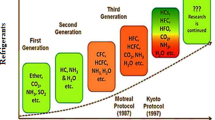A number of experimental measurements of the flash point of multicomponent mixtures were performed. A number of various theoretical models with experimental data has shown that traditional calculation models do not take into account the effect of high vapor pressure on the flash point temperature. The authors, using the UNIFAC method, proposed a modified model for calculating the flash point of multicomponent mixtures at high pressure. Comparative analysis of the models showed that the modified model allows obtaining design data that are in good agreement with the experimentally measured parameters of the well for a wide range of compositions of the mixture. The purpose of this work is to propose a model for calculating the flash point of a multicomponent mixture in a compressor system with increasing pressure, which does not require verification by experimental measurements. The model also makes it possible to evaluate the parameters of safe operation of compressor systems during air injection LTO of heavy oil reservoirs.


Similar content being viewed by others
References
Y. Wang, L. Zhang, J. Deng, et al., J. Petrol. Sci. Eng., 151, 254-263 (2017).
Z. Khansari, P. Kapadia, N. Mahinpey, et al., Energy, 64, No. 1, 419-428 (2014).
D. Kong, D. J. A. Ende, S. J. Brenek, et al., J. Hazard. Mater., 102, No. 2-3,155 (2003).
J. Deng, F. Cheng, and Y. Song, J. Loss. Prey. Process. Ind., 36, 45-53 (2015).
H. Le Chatelier, Annales des Mines, 19, No. 8, 388-395 (1891).
X. Liu and Z. Liu, J. Chem. Eng. Data., 55, No. 9, 2943-2950 (2010).
R. 0. Wickey and D. H. Chittenden, J. Hydrocarb. Process., 42, No. 6,157-158 (1963).
M. Hristova and D. Damgaliev, Central European Journal of Chemistry, 11, No. 3, 388-393 (2013).
W. A. Affens, J. Chem. Eng. Data,11, No. 2,197-202 (1966).
W. A. Affens and G W. McLaren, J. Chem. Eng. Data, 17, 482-488 (1972).
U. Weidlich and J. Gmehling, Ind. Eng. Chem. Res., 26, No. 7,1372-1381 (1987).
A. Fredenslund, J. Gmehling, and P. Rasmussen, Vapor-liquid Equilibria Using Unifac., 1, 134-149 (1977).
J. Gmehling and P. Rasmussen, Ind. Eng. Chem. Fundam., 21,186-188 (1982).
J. L. McGovern, J. Coat. TechnoL Res., 64, 33-38 (1992).
G Xu, D. Yang, P. Ning, et al., J. Chem. Thennodyn., 106, 295-302 (2017).
D. White, C. L. Beyler, C. Fulper, et al., J. Fin?. Safety, 28, No. 1, 1-31 (1997).
R. D. White, Drug Chem TbxicoL, 22, No. 1, 143-153(1999).
L. Catoire and V. Naudet, J. Phys. Chem. Ref. Data, 33, No. 4, 1083-1111 (2004).
L. Catoire, S. Paulmier, and V. Naudet, Process Saf Prog., 5, No. 1, 33-39 (2006).
H. J. Liaw, Y. H. Lee, C. L Tang, et al., Loss. Prey Process. Ind., 15, 429-438 (2002).
H. J. Liaw and Y. Y. Chiu, J. Hazard. Mater, 101, No. 2, 83-106 (2003).
H. J. Liaw, C. L. Tang, and I. S. Lai, Combust Flame, 138, No. 4, 308-319 (2004).
H. J. Liaw and Y. Y. Chiu, J. Hazard. Mater, 137, No. 1, 38-46 (2006).
H. J. Liaw and T. A. Wang, J. Hazard. Mater., 141, No. 1, 193-201 (2007).
H. J. Liaw, W. H. Lu, V. Gerbaud, et al., J. Hazard. Mater, 153, No. 3,1165-1175 (2008).
H. J. Liaw, V. Gerbaud, and C. Y. Chiu, I Chem. Eng. Data, 55, No. 1,134-146 (2010).
H. J. Liaw, V. Gerbaud, and Y. H. Li, Fluid Phase Equilibr, 300, No. 1-2, 70-82 (2011).
H. J. Liaw and H. Y. Cheri, Ind. Eng. Chem. Res., 52, No. 22, 7579-7585 (2013).
IL G Montemayor, M. A. Collier, and G G Lazarczyk, J. Test. EvaL, 30, No. 1, 74-84 (2002).
N. Calvar, A. Dominguez, and E. A. Macedo, J. Chem. Thermodyn., 66,137-143 (2013).
C. Antoine, Comptes Rendus, 107, 681-836 (1988).
T. P. Tsai and H. J. Liaw, A* Mater, 560-561,1178-1183 (2012).
H. Zhang, H. Duan, J. Zuo, et al., J. Environ. Manage., 199, 21-30 (2017).
Acknowledgement
This work was financially supported by China National Petroleum Corporation Ltd. (PRC).
Author information
Authors and Affiliations
Corresponding author
Additional information
Translated from Khimiya i Tekhnologiya Topliv i Masel, No. 2, pp. 46 — 52, March—April, 2019.
Rights and permissions
About this article
Cite this article
Wang, K., He, Y. Modified Models for Prediction of Flash Point of Multicomponent Mixtures in Air Compressor Systems for Low-Temperature Oxidation Processes of Air Injection in Heavy Oil Reservoirs. Chem Technol Fuels Oils 55, 189–198 (2019). https://doi.org/10.1007/s10553-019-01020-w
Published:
Issue Date:
DOI: https://doi.org/10.1007/s10553-019-01020-w




